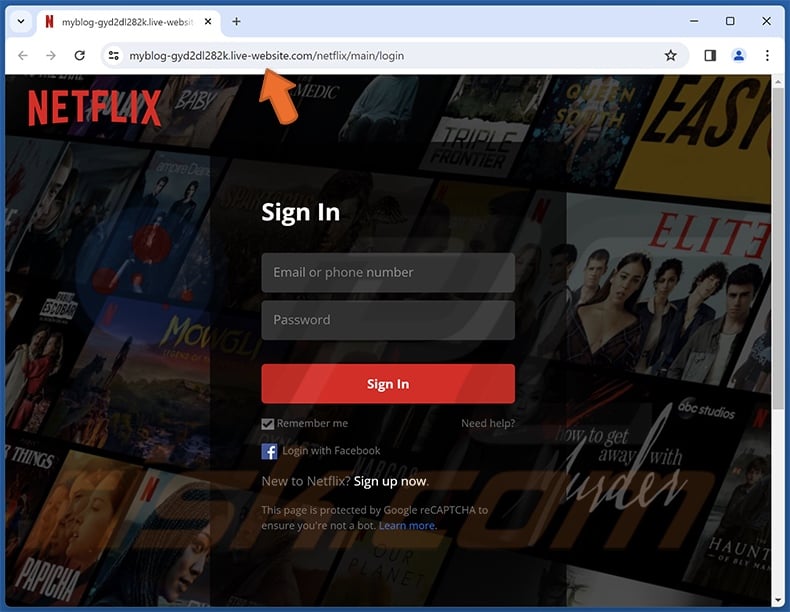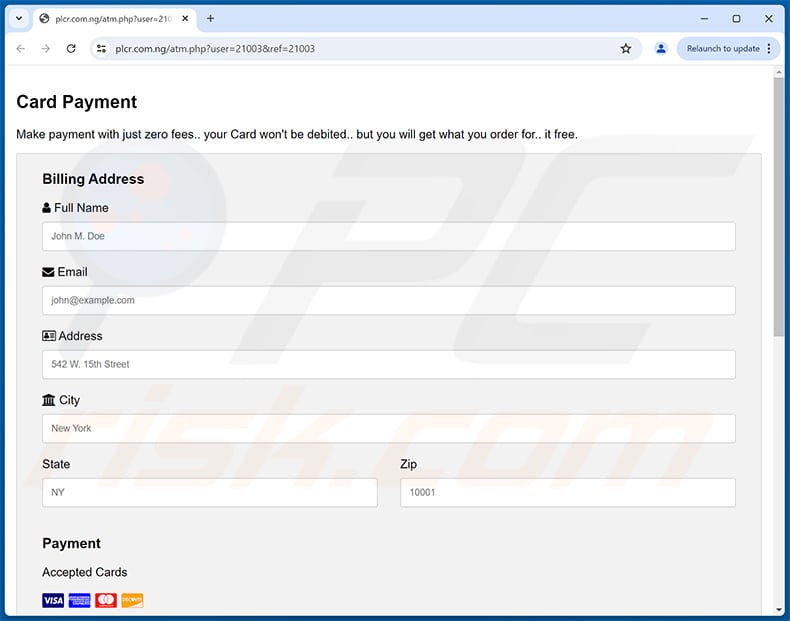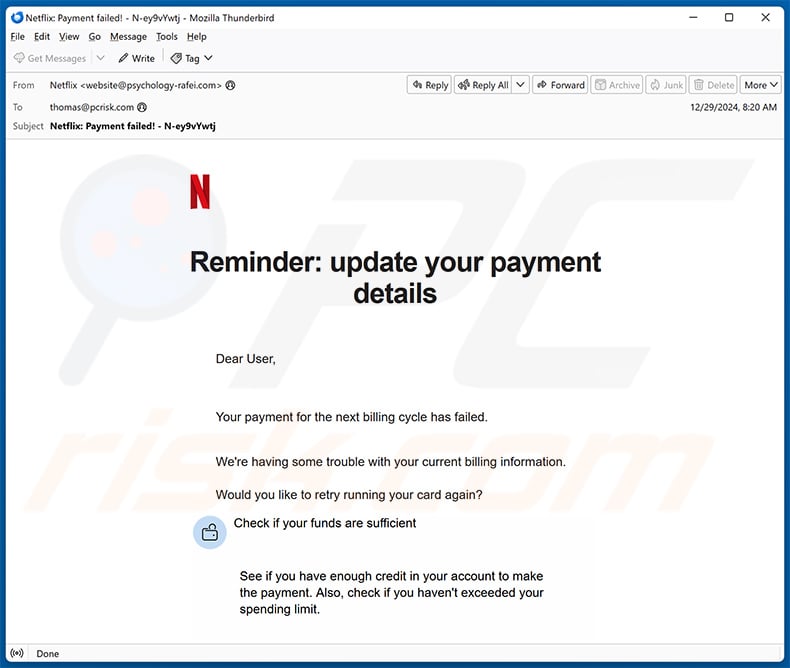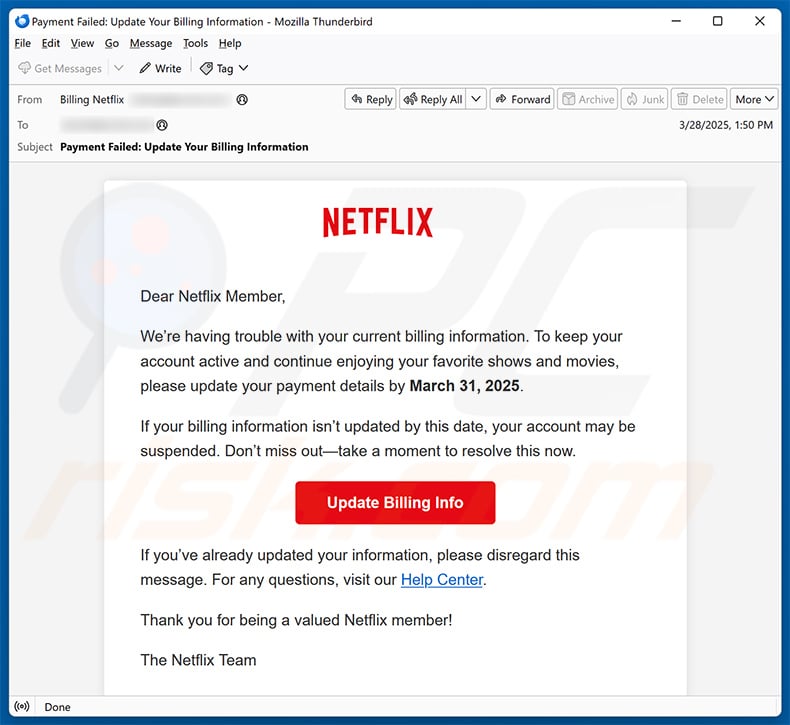Avoid losing your Netflix account via fake "Update Your Payment Details" email
Phishing/ScamAlso Known As: "Netflix - Update Your Payment Details" phishing email
Get free scan and check if your device is infected.
Remove it nowTo use full-featured product, you have to purchase a license for Combo Cleaner. Seven days free trial available. Combo Cleaner is owned and operated by RCS LT, the parent company of PCRisk.com.
What kind of email is "Netflix - Update Your Payment Details"?
Upon inspection, we determined that the "Netflix - Update Your Payment Details" email is fake. This spam letter states that there are issues regarding the billing information on the recipient's Netflix account.
It must be emphasized that this mail is not associated with the actual Netflix streaming service. The goal of this phishing email is to obtain the account's log-in credentials and potentially the victim's financial information.

"Netflix - Update Your Payment Details" email scam overview
The scam email with the subject "Update required – Netflix account on hold" (may vary) states that the recipient's account is on hold. The recipient is requested to update the payment details on the account, as there is an unspecified issue with the current information.
As mentioned in the introduction, the claims made by this email are false, and this mail is in no way associated with the Netflix streaming platform.
This letter promotes a phishing website that imitates the Netflix sign-in page. Log-in credentials entered into this site will be recorded and sent to scammers, thus allowing them to steal the exposed account.
It is pertinent to mention that the financial data mentioned in the email could be targeted as well. With this information in their possession (e.g., banking account details, credit card numbers, etc.), cyber criminals may be able to make unauthorized transactions and online purchases.
To summarize, victims of spam mail like "Netflix - Update Your Payment Details" can experience severe privacy issues, financial losses, and even identity theft.
If you have provided your log-in credentials – immediately change the passwords of all potentially exposed accounts and inform their official support. And if you've disclosed your personally identifiable or finance-related data – contact the appropriate authorities without delay.
| Name | "Netflix - Update Your Payment Details" phishing email |
| Threat Type | Phishing, Scam, Social Engineering, Fraud |
| Fake Claim | There are payment data issues on the recipient's Netflix account. |
| Disguise | Netflix |
| Related Domains | live-website[.]com, secure-allreviewschecked[.]es |
| Detection Names (live-website[.]com) | CyRadar (Malicious), Seclookup (Malicious), Webroot (Malicious), Full List Of Detections (VirusTotal) |
| Symptoms | Unauthorized online purchases, changed online account passwords, identity theft, illegal access of the computer. |
| Distribution methods | Deceptive emails, rogue online pop-up ads, search engine poisoning techniques, misspelled domains. |
| Damage | Loss of sensitive private information, monetary loss, identity theft. |
| Malware Removal (Windows) |
To eliminate possible malware infections, scan your computer with legitimate antivirus software. Our security researchers recommend using Combo Cleaner. Download Combo CleanerTo use full-featured product, you have to purchase a license for Combo Cleaner. 7 days free trial available. Combo Cleaner is owned and operated by RCS LT, the parent company of PCRisk.com. |
Phishing spam campaign examples
We have examined thousands of spam emails; "Cashier Check", "Upgrade Mailbox Quota", "Visa Awards", and "Microsoft Password System Reminder" are merely a few examples of ones used for phishing.
However, other scams are promoted using deceptive emails as well. Additionally, this mail is used to proliferate malware. While these letters are often basic and riddled with errors, they can also be competently disguised as messages from legitimate companies, service providers, institutions, authorities, and other entities.
How do spam campaigns infect computers?
Spam campaigns are commonly used to spread malware. The emails/messages can have infectious files attached to or linked inside them. These files can be executables (.exe, .run, etc.), archives (ZIP, RAR, etc.), documents (Microsoft Office, Microsoft OneNote, PDF, etc.), JavaScript, and so forth.
When such a file is opened – the malware download/installation process is triggered. Some formats may need additional actions to jumpstart system infection chains. For example, Microsoft Office files require users to enable macro commands (i.e., editing/content), while OneNote documents need them to click on embedded files/links.
How to avoid installation of malware?
We highly recommend being careful with incoming emails, PMs/DMs, SMSes, and other messages. Attachments or links present in suspicious/irrelevant mail must not be opened, as they can be malicious. Another recommendation is to use Microsoft Office versions released after 2010 since they have the "Protected View" mode that prevents automatic macro execution.
However, malware is distributed using other techniques as well. Therefore, we also advise being cautious while browsing since fake and dangerous online content usually appears legitimate and harmless.
Additionally, all downloads must be performed from official and verified channels. Another recommendation is to activate and update software using genuine functions/tools, as illegal activation tools ("cracks") and third-party updaters can contain malware.
We must emphasize the importance of having a dependable anti-virus installed and kept up-to-date. Security programs must be used to run regular system scans and to remove detected threats. If you've already opened malicious attachments, we recommend running a scan with Combo Cleaner Antivirus for Windows to automatically eliminate infiltrated malware.
Text presented in the "Netflix - Update Your Payment Details" spam email letter:
Subject: Update required – Netflix account on hold
Netflix
Your account is on hold.
Please update your payment details
Hi,
We're having some trouble with your current billing information. Would you like to retry running your card again? Your card information is below.
Your Card
MASTERCARD
•••• •••• •••• ••••
Expires (MM/YY)
XX/XX
Retry Payment
Enter New Payment Method
We're here to help if you need it. Visit the Help Center for more info or contact us.
The Netflix team
Appearance of the "Netflix - Update Your Payment Details" spam email (GIF):

Screenshot of the phishing website promoted by the "Netflix - Update Your Payment Details" spam campaign:

Other examples of emails from "Netflix - Update Your Payment Details" spam campaign:
Sample 1:

Text presented within:
Subject: Membership Reminder
NETFLIX
Payment Decline
Dear Customer,
We were unable to validate your billing information for the next billing cycle of your subscription therefore we'll suspend your membership if we do not receive a response from you within 48hours.
Obviously we'd love to have you back, simply click on RETRY PAYMENT to update your details and continue to enjoy all the best TV shows & movies without interruption.
RETRY PAYMENT
The Netflix team
Screenshot of the promoted phishing site:

Sample 2:

Text presented within:
Subject: Netflix: Payment failed! - N-ey9vYwtj
Netflix
Reminder: update your payment detailsDear User,
Your payment for the next billing cycle has failed.
We're having some trouble with your current billing information.Would you like to retry running your card again?
[step 2] Check if your funds are sufficient
See if you have enough credit in your account to make the payment. Also, check if you haven't exceeded your spending limit.
[step 2] Make sure all provided information is correct
If you tried to pay with a card, make sure it's valid, and the details you entered match the information on the card.
[step 2] Try another payment method
You can choose from several ways to pay for your subscription – try using a different one.
Retry PaymentNetflix Unsubscribe here | Manage your email preferences
Screenshot of the promoted phishing site:
![Fake Netflix website - secure-allreviewschecked[.]es - promoted via Netflix-themed email scam (2025-01-02)](/images/stories/screenshots202501/netflix-update-your-payment-details-email-scam-update-2025-01-02-phishing-site.jpg)
Sample 3:

Text presented within:
Subject: Payment Failed: Update Your Billing Information
Dear Netflix Member,
We're having trouble with your current billing information. To keep your account active and continue enjoying your favorite shows and movies, please update your payment details by March 31, 2025.
If your billing information isn't updated by this date, your account may be suspended. Don't miss out—take a moment to resolve this now.
Update Billing InfoIf you've already updated your information, please disregard this message. For any questions, visit our Help Center.
Thank you for being a valued Netflix member!
The Netflix Team
This email was sent by Netflix. © 2025 Netflix, Inc. All rights reserved.
Instant automatic malware removal:
Manual threat removal might be a lengthy and complicated process that requires advanced IT skills. Combo Cleaner is a professional automatic malware removal tool that is recommended to get rid of malware. Download it by clicking the button below:
DOWNLOAD Combo CleanerBy downloading any software listed on this website you agree to our Privacy Policy and Terms of Use. To use full-featured product, you have to purchase a license for Combo Cleaner. 7 days free trial available. Combo Cleaner is owned and operated by RCS LT, the parent company of PCRisk.com.
Quick menu:
- What is "Netflix - Update Your Payment Details" phishing email?
- Types of malicious emails.
- How to spot a malicious email?
- What to do if you fell for an email scam?
Types of malicious emails:
![]() Phishing Emails
Phishing Emails
Most commonly, cybercriminals use deceptive emails to trick Internet users into giving away their sensitive private information, for example, login information for various online services, email accounts, or online banking information.
Such attacks are called phishing. In a phishing attack, cybercriminals usually send an email message with some popular service logo (for example, Microsoft, DHL, Amazon, Netflix), create urgency (wrong shipping address, expired password, etc.), and place a link which they hope their potential victims will click on.
After clicking the link presented in such email message, victims are redirected to a fake website that looks identical or extremely similar to the original one. Victims are then asked to enter their password, credit card details, or some other information that gets stolen by cybercriminals.
![]() Emails with Malicious Attachments
Emails with Malicious Attachments
Another popular attack vector is email spam with malicious attachments that infect users' computers with malware. Malicious attachments usually carry trojans that are capable of stealing passwords, banking information, and other sensitive information.
In such attacks, cybercriminals' main goal is to trick their potential victims into opening an infected email attachment. To achieve this goal, email messages usually talk about recently received invoices, faxes, or voice messages.
If a potential victim falls for the lure and opens the attachment, their computers get infected, and cybercriminals can collect a lot of sensitive information.
While it's a more complicated method to steal personal information (spam filters and antivirus programs usually detect such attempts), if successful, cybercriminals can get a much wider array of data and can collect information for a long period of time.
![]() Sextortion Emails
Sextortion Emails
This is a type of phishing. In this case, users receive an email claiming that a cybercriminal could access the webcam of the potential victim and has a video recording of one's masturbation.
To get rid of the video, victims are asked to pay a ransom (usually using Bitcoin or another cryptocurrency). Nevertheless, all of these claims are false - users who receive such emails should ignore and delete them.
How to spot a malicious email?
While cyber criminals try to make their lure emails look trustworthy, here are some things that you should look for when trying to spot a phishing email:
- Check the sender's ("from") email address: Hover your mouse over the "from" address and check if it's legitimate. For example, if you received an email from Microsoft, be sure to check if the email address is @microsoft.com and not something suspicious like @m1crosoft.com, @microsfot.com, @account-security-noreply.com, etc.
- Check for generic greetings: If the greeting in the email is "Dear user", "Dear @youremail.com", "Dear valued customer", this should raise suspiciousness. Most commonly, companies call you by your name. Lack of this information could signal a phishing attempt.
- Check the links in the email: Hover your mouse over the link presented in the email, if the link that appears seems suspicious, don't click it. For example, if you received an email from Microsoft and the link in the email shows that it will go to firebasestorage.googleapis.com/v0... you shouldn't trust it. It's best not to click any links in the emails but to visit the company website that sent you the email in the first place.
- Don't blindly trust email attachments: Most commonly, legitimate companies will ask you to log in to their website and to view any documents there; if you received an email with an attachment, it's a good idea to scan it with an antivirus application. Infected email attachments are a common attack vector used by cybercriminals.
To minimise the risk of opening phishing and malicious emails we recommend using Combo Cleaner Antivirus for Windows.
Example of a spam email:

What to do if you fell for an email scam?
- If you clicked on a link in a phishing email and entered your password - be sure to change your password as soon as possible. Usually, cybercriminals collect stolen credentials and then sell them to other groups that use them for malicious purposes. If you change your password in a timely manner, there's a chance that criminals won't have enough time to do any damage.
- If you entered your credit card information - contact your bank as soon as possible and explain the situation. There's a good chance that you will need to cancel your compromised credit card and get a new one.
- If you see any signs of identity theft - you should immediately contact the Federal Trade Commission. This institution will collect information about your situation and create a personal recovery plan.
- If you opened a malicious attachment - your computer is probably infected, you should scan it with a reputable antivirus application. For this purpose, we recommend using Combo Cleaner Antivirus for Windows.
- Help other Internet users - report phishing emails to Anti-Phishing Working Group, FBI’s Internet Crime Complaint Center, National Fraud Information Center and U.S. Department of Justice.
Frequently Asked Questions (FAQ)
Why did I receive this email?
Spam emails are not personal, even if they include details relevant to the recipients. This mail is sent out in massive campaigns – hence, thousands of users receive identical emails.
I have provided my personal information when tricked by this spam email, what should I do?
If you've provided your log-in credentials – change the passwords of all possibly exposed accounts and inform their official support. However, if you have disclosed other private data (e.g., ID card details, credit card numbers, etc.) – immediately contact the corresponding authorities.
I have read a spam email but didn't open the attachment, is my computer infected?
No, opening/reading an email will not initiate any malware download/installation processes. Devices are infected when malicious attachments or links are opened.
I have downloaded and opened a file attached to a spam email, is my computer infected?
Whether the system was compromised might depend on the opened file's format. If it was an executable (.exe, .run, etc.) – most likely, as these files cause infections almost without fail. However, you might have avoided an infection if it was a document (.doc, .xls, .pdf, .one, etc.). These formats may need additional actions to start downloading/installing malware (e.g., enabling macro commands, clicking embedded files/links, etc.).
Will Combo Cleaner remove malware infections present in email attachments?
Yes, Combo Cleaner is capable of detecting and eliminating nearly all known malware infections. Note that high-end malicious programs usually hide deep in the system – therefore, running a complete system scan is essential.
Share:

Tomas Meskauskas
Expert security researcher, professional malware analyst
I am passionate about computer security and technology. I have an experience of over 10 years working in various companies related to computer technical issue solving and Internet security. I have been working as an author and editor for pcrisk.com since 2010. Follow me on Twitter and LinkedIn to stay informed about the latest online security threats.
PCrisk security portal is brought by a company RCS LT.
Joined forces of security researchers help educate computer users about the latest online security threats. More information about the company RCS LT.
Our malware removal guides are free. However, if you want to support us you can send us a donation.
DonatePCrisk security portal is brought by a company RCS LT.
Joined forces of security researchers help educate computer users about the latest online security threats. More information about the company RCS LT.
Our malware removal guides are free. However, if you want to support us you can send us a donation.
Donate
▼ Show Discussion